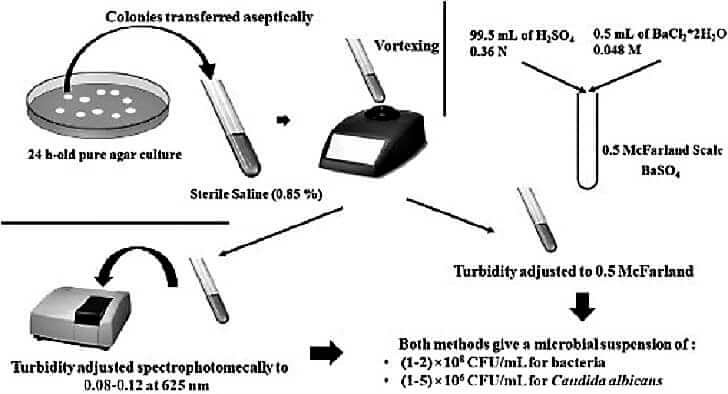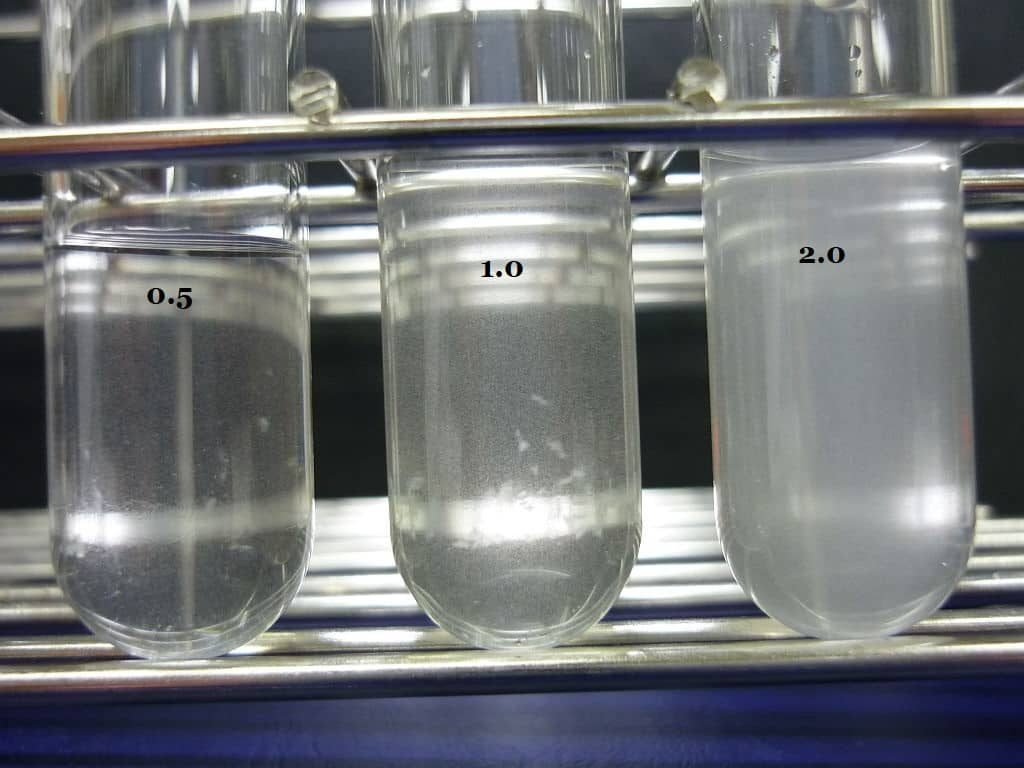The McFarland Standards are commonly used in Antibiotic Susceptibility Test (AST) to standardize the approximate number of bacteria in a liquid suspension or broth culture of the bacterial cell by comparing the turbidity of the cultured test suspension with that of the McFarland Standard.
Principle of McFarland Standard Solution
A McFarland Standard is a chemical solution of 1% barium chloride (BaCl2) and 1% sulfuric acid (H2SO4) Solution in appropriate proportion; the reaction between these two chemicals results in the turbid solution which is due to the production of a fine precipitate of barium sulfate (BaSO4). Thus prepared turbid solution is used as a standard solution to which the cultures bacterial suspensions are compared and standardized.
Variations in McFarland Solution
When shaken well and the precipitates distributed homogenously in the solution, the turbidity of a McFarland Standard is visually comparable to a bacterial suspension of cultured broth and the approximate concentration of the Bacteria in suspension can be determined as described below:
| McFarland Standard | 1% BaCl2 (in ml) | 1% H2 SO4 (in ml) | Approximate Cell density (the CFU) / ml |
|---|---|---|---|
| 0.5 | 0.05 | 9.95 | 1.5 x 108 |
| 1.0 | 0.1 | 9.9 | 3.0 x 108 |
| 2.0 | 0.2 | 9.8 | 6.0 x 108 |
| 3.0 | 0.3 | 9.7 | 9.0 x 108 |
| 4.0 | 0.4 | 9.6 | 1.2 x 109 |
| 5.0 | 0.5 | 9.5 | 1.5 x 109 |
| 6.0 | 0.6 | 9.4 | 1.8 x 109 |
| 7.0 | 0.7 | 9.3 | 2.1 x 109 |
| 8.0 | 0.8 | 9.2 | 2.4 x 109 |
| 9.0 | 0.9 | 9.1 | 2.7 x 109 |
| 10.0 | 1.0 | 9.0 | 3.0 x 109 |
Prior to use, the McFarland Standard solution should be shaken up well and transferred into a test tube identical to those used to prepare the Bacterial suspension. Once the McFarland standard is transferred to the tubes, tightly seal the tubes to prevent evaporation of the solution. Before each use, shake well the McFarland solution to ensure that the barium sulfate (BaSO4) is distributed evenly throughout the solution making a homogeneous solution.
Procedure for the preparation of 0.5 McFarland Standard
⇒ Prepare a 1% Barium Chloride (BaCl2) solution by mixing 1gram of anhydrous barium chloride (BaCl2) in 100 ml Distilled water.
⇒ Also, prepare a 1% Sulfuric Acid (H2SO4) solution by mixing 1 ml of concentrated H2SO4 in 99 ml of Distilled water.
⇒ Now, Mix the 1% Barium chloride (BaCl2) & 1% Sulfuric acid (H2SO4) in an appropriate proportion as per the concentration required. Most commonly 0.5 McFarland Solution is used as a standard for Antibiotic Susceptibility test (AST) which is prepared by mixing 0.05 ml (or 50 µl) BaCl2 in 9.95 ml of 1% H2SO4 solution. Mix well the prepared solution to form a turbid suspension.
Note: – Refer the Table described in the variations in McFarland Standard section for the Proportion of BaCl2 and H2SO4 for the preparation of McFarland standard at various concentrations.

⇒ Keep the resulting mixture in a screw cap tube covered with the Aluminium foil to prevent the evaporation of the solution.
⇒ McFarland standard density solution will precipitate and clump over time, and it needs vigorous vortexing before each use.
⇒ Mark the tubes containing McFarland solution to indicate the concentration as 0.5 or 1.0 or any concentration, and every time before using the solution check it to be sure that evaporation has not occurred which may give erroneous results.
⇒ For better results and accuracy in procedures, in every 6 months prepare a fresh McFarland standard solution of required concentration.
PREPARATION OF MUELLER HINTON AGAR MEDIA (MHA) IN LABORATORY
Matching the Test Suspension with McFarland Standard Solution
⇒ The Density of the cultured suspension of the bacterial cells is compared to the McFarland turbidity standard by holding the bacterial suspension and McFarland turbidity standard in front of a light against a white background with contrasting black lines
0.5 McFarland turbidity standard for antimicrobial susceptibility testing a.k.a. Antibiotic Sensitivity Test (AST) purpose)
⇒ If the bacterial density is too heavy in the cultured broth, the suspension should be diluted with saline, Peptone water or broth (whichever was used to culture and to make the bacterial suspension) and if the Bacterial density is not sufficient, then additional bacteria should be added to the suspension or it can be cultured for some more time until the required turbidity appears. The adjusted bacterial suspensions should be used as inoculation within 15-20 minutes for Best results.
McFarland Equivalence Turbidity Standard solutions
⇒ The Original McFarland standard solutions were prepared by adding Barium Chloride (BaCl2) solution to the Sulfuric acid (H2SO4) solution in the appropriate proportion as the concentration of standard required, resulting in the formation of Barium Sulfate (BaSO4) precipitates. The turbid solution is then used as a standard and the Bacterial suspension is compared with the McFarland Standard to standardize the Suspension.
⇒ Nowadays, the McFarland Equivalence Turbidity Standards are prepared from suspensions of uniform polystyrene microparticles with absorbance values similar to the original Barium Sulfate (BaSO4) standards.

⇒ In this, the polystyrene microparticles are suspended in a special buffer solution and adjusted to an acceptable absorbance range using a spectrophotometer with a 1 cm light path set at 625 nm (nanometer), depending on the standard used.
⇒ Adjusting bacterial suspension turbidity to the McFarland Equivalence Turbidity Standard produces bacterial counts in an expected range as that of the BaSO4 Standards.
⇒ The McFarland Equivalence Turbidity Standards improves the Stability of suspensions, shelf life, and ease of comparison.
Limitations of McFarland Standards
⇒ The use of colored broth media like of dark yellow, orange, or brown in color may result in the bacterial suspensions of incorrect densities. For such types of cultures trial, comparisons should be performed.
⇒ Visually comparing McFarland Standards and bacterial suspensions by use of backlight illumination could result in bacterial suspensions of incorrect densities.
Precautions to be taken while Preparing & Using McFarland Standard Solution
⇒ Carefully dilute the Barium Chloride and Sulfuric acid solution. Sulfuric acid is corrosive, handle with care.
⇒ McFarland Standard solutions are sensitive to air and light, therefore, ensure that the tube containing McFarland Standard are closed tightly at all times and kept in the dark place.
⇒ Every time before using the McFarland Standard, the level of the standard solution should be checked to ensure that evaporation has not occurred. Discard if any volume is lost and prepare fresh McFarland Standard solution.
⇒ The McFarland Standard Solutions should be vigorously agitated and mixed on a mechanical vortex before each use and must be inspected for a uniform turbid appearance throughout the solution. In case, if large particles appear or if clumping is apparent in the solution discard the standard and prepare fresh McFarland Standard.
⇒ The Actual numbers of viable bacterial cells or Colony Forming Units (CFU) present in an adjusted suspension depend on the size, viability, and clumping of the particular bacterium used.
⇒ While matching the Bacterial Suspension with McFarland Standard solution, use adequate light to read the Standard and test broth culture against a white card with contrasting black lines.
⇒ Store the McFarland standard solution at room temperature (25 °C) or in between 4 °C – 25 °C when not in use.
Check out the Preparation of Mueller Hinton Agar Medium in Laboratory
Further Reading:
McFarland STANDARD BY DALYNN BIOLOGICALS
Methods for in vitro evaluating antimicrobial activity: A review

Hi, I’m the Founder and Developer of Paramedics World, a blog truly devoted to Paramedics. I am a Medical Lab Tech, a Web Developer and Bibliophiliac. My greatest hobby is to teach and motivate other peoples to do whatever they wanna do in life.
It’s great formations
It’s really easy to understand…Thank you…
Dear sir
The information about the Macfarland standard is understandable.
Please explain to me how to prepare the same dilution for the PCR validation method.